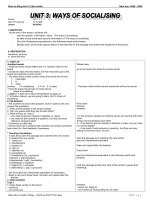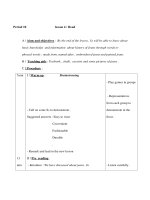Unit 2 (period 14-18)
Bạn đang xem bản rút gọn của tài liệu. Xem và tải ngay bản đầy đủ của tài liệu tại đây (255 KB, 8 trang )
Giáo án tiếng Anh 12 (bộ chuẩn) Năm học: 2008 - 2009
Period: 14
Date of Teaching: 17.9.2008
Lesson: READING
A. WARM UP
Jumbled words
- Write the words whose letters are in a random order on the
board.
- Divide the class into two teams. Ss from two teams go to the
board and write the correct words.
- The team which writes correct words first will be the winner.
1. osiacsilgin
2. fo
3. sawy
Answer : 1 socialising , 2 of , 3 ways
- Have Ss guess the phrase of words above
Ways of socialising
- Lead in: T asks Ss to open the textbook on page 31.
T: In today’s lesson, we are going to learn Unit 3- Ways of
socialising
B. PRE-READING
- Ask students to look at the pictures, work in pairs to ask and
answer the questions
1. What are the people in the picture doing?
2. Can you guess what they say to each other?
3. What will you do / say if:
+ you want to get your teacher’s attention in class?
+ you need to ask someone a question, but they are busy
talking to someone else?
- Go around to offer help.
- Call on some Ss to present their answers and elicits comments
from other Ss. Give feedback if necessary
* Teaching Vocabulary:
- T asks Ss to skim the passage and underline the new words.
- T explains the new words.
1. attract (v)
2. assistance(n)
3. whistle (v)
4. clap (v)
5. attention (n)
6. acceptable (a)
7.Compliment: (n): (synonym)
8.Decent: ( adj) (situation)
9.Appropriate: ( adj) ( translation)
10.Kidding(n) ( situation)
11.Signal (n): ( example)
12.Marvellous: ( adj): ( synonym)
- Ask Ss to give the Vietnamese equivalent (if necessary).
- Read a new word three times. Ss listen and repeat after the
teacher.
C. WHILE-READING
Task 1
T writes these words on the board:
- verbal (a)
A. WARM UP
Whole class
go to the board and write the correct words.
- The team which writes correct words first will be the winner
Pairs work
Discuss
Answers
1.In the pictures, people are shaking hands and waving with each
other.
2.they may be greeting each other
3. - If we want to get our teacher’s attention in class, we can raise
our hands slightly.
- If we need to ask someone a question, but they are busy
talking to someone else, we can…
skim the passage and underline the new words.
give the Vietnamese equivalent
listen and repeat after the teacher.
Copy down
give the Vietnamese equivalent to the following words and
phrases.
read the passage quickly and stop at the words to guess their
meanings.
Answers
- verbal (a): bằng lời
Giáo viên Lô Xuân Thống – THCS và THPT Chi Lăng 21 | P a g e
I. OBJECTIVES
By the end of the lesson, students will:
- read for specific information about The ways of socialising.
- be able to talk some back ground information of The ways of socialising.
- Give the Vietnamese equivalents to the following words and phrases.
- Decide which of the three options below is the best title for the passage and answer the questions of the lesson.
II. PREPARATION
Handouts, pictures
Giáo án tiếng Anh 12 (bộ chuẩn) Năm học: 2008 - 2009
- non-verbal (a)
- attract someone’s attention
- impolite (a) # polite (a)
- rude(a) # polite
- informality (adv) # formality
- approach (v)
- a slight nod will do
- Ask Ss to give the Vietnamese equivalent to the following words
and phrases.
- Instruct Ss to read the passage quickly and stop at the words to
guess their meanings.
- Guess the meaning of the words based on the context in the
sentences.
- Check that Ss understand the word correctly.
- Call some students to give the answers.
- Ask others students to correct.
- Give the true answers..
Task 2
- Ask students to read the questions carefully.
- Ask students to read through the passage again.
- Devide the class into pairs to do .
- Call some students to give the answers.
- Ask others students to correct.
- Give the true answers..
Task 3
Questions and answers
Ask Ss to work in pairs and ask and answer the questions in the
book basing on the information in the reading passage.
- Ask Ss to read the text again and write down the answers to the
following questions.
- T moves around class to give help.
- calls on some pairs to present their answers in front of the class
- gives correct answers
D. POST-READING
* Discussion
- Ask Ss to work in pairs to discuss the meaning of whisling and
hand- clapping in Vietnamese culture.
- Move around to help Ss.
- Ask some pairs to act out their conversation.
- T gives feedback.
E. HOMEWORK:
- asks Ss to learnt by heart the lesson
- reviews the points that have been covered in the lesson and do
the exercise in the exercise book.
- prepare the next part: Speaking
F. COMMENT
- non-verbal (a); không bằng lời, phi ngôn
- attract someone’s attention: thu hút sự chú ý của ai
- impolite (a) # polite (a): không lịch sự
- rude(a) # polite: thô lỗ
- informality (adv) # formality: thân mật, không nghi thức
- approach (v): tiếp cận
- a slight nod will do: một cái gật đầu nhẹ là đủ
Work in pairs
read the passage more carefully & choose the best title for it.
Answers
A. ( Attracting Attention: Non- verbal Cues)
work in pairs and ask and answer the questions in the book basing
on the information in the reading passage.
Answers
1. We can use either verbal or non- verbal communication.
2. Because they are strong actions that can easily be seen
3. We can wait until he passes near us, catch his eye, nod
slightly to let him know we would like him to come to our
table. Or we may raise our hand slightly to show that we
need assistance.
4.You can use a small friendly wave to attract his or her
attention.
5. Because it’s considered rude.
work in pairs to discuss the meaning of whisling and hand-
clapping in Vietnamese culture.
WLE-READING
.POST-READING EOMEWORK F. COMMENTS
Period: 15
Date of Teaching: 19.9.2008
Lesson: SPEAKING
Giáo viên Lô Xuân Thống – THCS và THPT Chi Lăng 22 | P a g e
I. OBJECTIVES
By the end of the lesson, students will:
- practise speaking exactly and appropriately about the ways of socialising, based on the vocabulary and structures that they have
learnt in the lesson.
- make dialogues to practise giving and responding to compliments, based on the given information.
II. PREPARATION
textbook, pictures, cassette, tape, handouts and real objects
III. PROCEDURES
Giáo án tiếng Anh 12 (bộ chuẩn) Năm học: 2008 - 2009
A. WARM UP
Guessing word:
T: What is it?
Divide the class into two groups.
T says that he has a word in his mind and he going to give some
information about the word. Members of each group will listen and
may stop at any information they hear to guess what the word is.
Each group has only two chances to gues the word. The first
group to tell exactly what the word is wins the game.
T gives information about the word.
1. It’s a noun.
2. It has got ten letters.
3. It is an expression by word or action, or admiration.
4. It shows one respect, give and respond your feeling about
things which are beautiful, good, or interesting, etc.
What is the word?
T gives the correct answer.
Answer key: COMPLIMENT
B. PRE-READING
Task 1:
- Introduces the task: You are going to work in your group to
practise reading these dialogues, paying attention to how
people give and respond to compliments in each situation.
Elicit the new words by asking Ps.
Vocabulary:
- compliments(n)
- hairstyle(n)
- terrific(a)
- kidding(a)
Ask Ps to take notes and practise reading vocabulary.
Ask Ps to work in pairs, practise reading these dialogues, paying
attention to how people give and respond to compliments in each
situation.
T reads once. Ask Ps to listen.
Hang the table on the board. Ask Ps to look at the information
about compliments in the table.
Useful language:
Give compliments Respond to compliments
- beautiful
- perfect
- I’ve never seen…
- terrific
- better
- I think
- What a/an……you have/ have
got!
- How + adj/adv…………
- You really have……………
- Your ……is/are…
- Thank you/ Thanks
- That’s a nice compliment
I think
- I’m glad you like it.
- Thank you. I think/
thought……………
- Thank you. That’s a nice
compliment.
- You must be kidding.
- Ask Ss to use the information in the table to suitable information
and play the roles in the dialogues to practise the dialogues.
- Move around to give help
C. WHILE-READING
Task 2:
- Read the cues once. Ask Ss to listen and look at the information
in the task.
- Explain the situations of each dialogues.
- Guide Ss to use suitable compliments in each dialogues, using
the cues.
- Ask Ss to work in pairs, practise giving compliments to suit the
responses.
Move around to give help.
- Call on some pairs to act out their conversation in front of the
class.
- Give comments on their conversations.
Task 3
- Read the cues once. Ask Ss to listen and look at the information
A. WARM UP
- Listen to the teacher.
- Work in groups
- Listen and find out the answers.
- Work in pairs
- Look at the table on the board.
- Listen to the teacher.
- Take notes.
use the information in the table to suitable information
and play the roles in the dialogues to practise the
dialogues.
- Work in pairs.
listen and look at the information in the task.
- Some pairs perform. Others listen.
David: You really have a beautiful dress. It is the most beautiful
dress I have seen.
Hung: Your motorbike is really terrific. Then…
Michel: I thought your badminton was a lot better ….
- Work in groups.
- Listen to the teacher.
- Listen to the teacher.
- Act out their conversation in front of the class.
- Thank you, Phil. I think you can do it as well as I do.
Giáo viên Lô Xuân Thống – THCS và THPT Chi Lăng 23 | P a g e
Giáo án tiếng Anh 12 (bộ chuẩn) Năm học: 2008 - 2009
in the task.
- Explain the situations of each dialogues.
- Guide Ss to use suitable compliments in each dialogues, using
the cues.
Ask Ss to work in pairs, practise responding compliments to suit
the responses.
Move around to give help.
- Call on some pairs to act out their conversation in front of the
class.
- Give comments on their conversations.
D. POST-READING
Task 4:
- Before getting Ss to discuss, T reminds them of some useful
expressions for giving and responding compliments in Task 1.
- Divide the class into small groups of 3 or 4 & gets them to
discuss the task.
- Go around to check and offer help.
- After checking that all the groups have finished, T calls on the
representative of each group to report their peer’ ideas. T check if
other groups would have the same or different ideas.
- Listen & take note of their errors. T provides corrective feedback
after that.
E. HOMEWORK
Work with your friends: Make compliments and responses about
something or performances of your friends in class.
- study
- speaking English
- singing
- briefcase/ a new pen/ a nice hat/
- Prepare the next part.
F. COMMENT
- Thank you, Peter. That’s a nice compliment.
- You must be kidding. I think it is acceptable
Work in pairs
Share with the other pairs.
Present the dialogues
Take note teacher’s feedback
• A nice pair of glasses:
A: Your pair of glasses are really nice. I really like them.
B: Really, Peter. I just bought it yesterday.
• A new and expensive watch;
A: You really have a new and expensive watch, ……… How
did you get it?
B: Thank you, ……… My father bought it for me on my
birthday.
• A new cell phone:
A: Your new cell phone looks great. I have never seen such a
nice one before.
B: Thanks. I finally found a suitable one for me
WHILE-READING
. POST-READING EOMEWORK F. COMMENTS
Period: 16
Date of Teaching: 21.9.2008
Lesson: LISTENING
A. WARM UP
Jumbled words:
Write the words whose letters are in a random order on the board.
- Divide the class into two teams. Ss from two teams go to the
board and write the correct words.
- The team which writes correct words first will be the winner.
aniotuergl regulation
oenetlehp telephone
lacl call
acidev advice.
B. PRE-READING
T sets the scene: You are going to listen to Linda Cupple, a social
worker, advises young people on how to use the telephone in her
family. Listen to her talk and decide whether the statements are
true(T) or false (F).
Ask Ps to look at the pictures in the textbook and answer the
questions.
Elicit the new words by asking questions, using the techniques
suggested above.
Vocabulary:
- argument (n)
- regulation (n)
- absolute (a)
- maximum (n,a)
A
Pairs work
Rearrange
Whole class
Listen to the teacher
look at the pictures in the textbook and answer the questions.
Answer the teacher's questions.
Giáo viên Lô Xuân Thống – THCS và THPT Chi Lăng 24 | P a g e
I. OBJECTIVES
By the end of the lesson, students will:
- Develop extensive listening skills.
- Use the information they have listened to for other communicative tasks..
II. PREPARATION
III. PROCEDURES
Giáo án tiếng Anh 12 (bộ chuẩn) Năm học: 2008 - 2009
- install (v)
- chitchat (n)
- starling (a)
Listen and repeat:
- Help Ss to pronounce the words in their book correctly.
- Play the tape and then ask Ss to repeat after the tape in chorus
and individually.
- T corrects errors, if any.
- Check that Ss know the meaning of these words.
C. WHILE-READING
Task 1:
- Get Ss to read through the statements to understand them and
underline the key words.
- Guide students the requests of the task.
- Let students listen twice time.
- Write on board from 1 to 6 and call some students to come and
write their answers.
- Let them listen on again and correct.
- Correct.
Task 2: Gap- fill
T: Now listen to the rest of the listening text again and work in
pairs to write the missing words. You will listen to the tape twice.
Check if Ps can answer the questions in task 2 without listening
again. Play the tape for them to listen again but before doing this,
T should encourage Ps to read through all the questions, identify
the information they need to look for in each question
Play the tape again for Ps to listen & answer the questions
Get Ps to check their answers with a partner. Then T checks with
the whole class.
Play the tape twice.
Call on some pairs to give the answers.
Go over the answers with the class.
D. POST-READING
- Before getting Ss to summarize Ms Linda Cupple’s talk, T
reminds them of some useful languages Task 1,2.
Suggested ideas:
- Length of time for each call
- Time for calling
- Calling late at night
- Calling at weekend
-Divide the class into small groups of 3 or 4 & gets them to
summarise the listening passage.
- Go around to check and offer help.
- After checking that all the groups have finished, T calls on the
representative of each group to report their peer’ ideas. T check if
other groups would have the same or different ideas.
- Listen & take note of their errors. T provides corrective
feedback after that.
E. HOMEWORK
- Learn the new words by heart.
- Review the points that have been covered in the lesson and do
the exercise in the exercise book
- Prepare the next part.
F. COMMENT
+ They are greeting….
+ They are saying goodbye…
Take notes
Listen to the tape and read in chorus & individually
Individual work, pair work & whole class.
read through all the questions, identify the information they need
to look for in each question ( question word: what, where, when,
how…)
listen and answer the questions
answers
1. T
2. F
3. T
4. F
5. F
6. T
Individual work, pair work & whole class.
read through all the questions, identify the information they need
to look for in each question
check their answers with a partner
give the answers.
Answer:
1. agreed 5. waking
2. to avoid 6. heart
3. particular 7. kindness
4. adults 8. to stick
Individual work, pair work & whole class.
summarize Ms Linda Cupple’s talk. WARM UP
C. WHILE-READING
. POST-READING EOMEWORK F. COMMENTS
Giáo viên Lô Xuân Thống – THCS và THPT Chi Lăng 25 | P a g e









